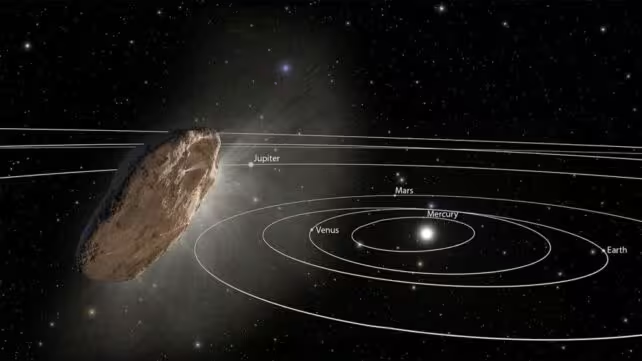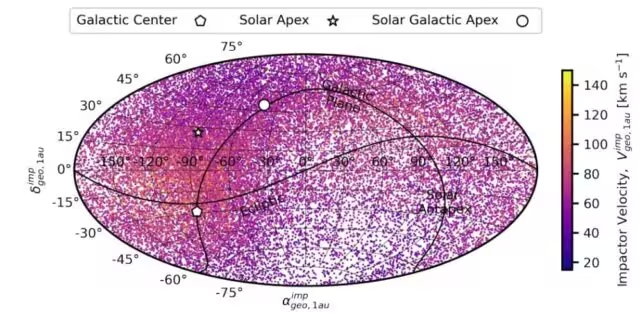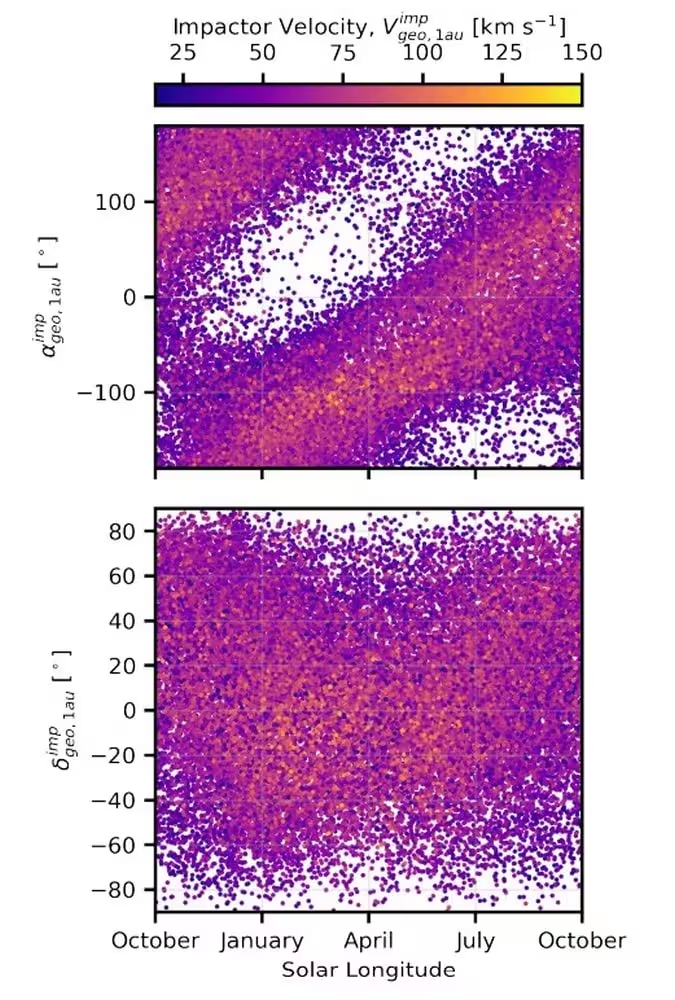10 Minutes
Earth has already been visited by a handful of interstellar objects (ISOs), and new research suggests impacts from these wanderers are not uniformly distributed across the globe. By modelling the incoming directions, speeds and seasonal patterns of hypothetical Earth-impacting ISOs, astronomers are beginning to map where and when these rare visitors pose the greatest risk.
Interstellar visitors: a brief primer
Our neighborhood in space has seen at least three confirmed interstellar interlopers: the cigar-shaped 1I/'Oumuamua in 2017, comet 2I/Borisov in 2019, and the recently observed 3I/ATLAS. These objects originate from other star systems, traveling through the Milky Way before crossing our Solar System. Given the Galaxy's age and vast population of planetary systems, researchers reasonably infer that a great many ISOs have traversed—and some may have collided with—Earth over the past 4.6 billion years.

This artist's illustration shows the interstellar object (ISO) Oumuamua travelling through our Solar System. We know of three ISOs, but there must be many more. What risk do they pose to Earth?
The early Solar System was far more chaotic than it is today: collisions between planetesimals and protoplanets shaped the terrestrial planets and cleared much of the impactor population. ISOs, however, are not tied to that local population and could continue to arrive at roughly constant rates over cosmic time. So what can we say about the likelihood of an ISO striking Earth, and where such an impact would most probably occur?
How the study modeled impact risk
A recent paper titled "The Distribution of Earth-Impacting Interstellar Objects," led by Darryl Seligman (Michigan State University), addresses precisely that question by simulating a synthetic population of interstellar objects and tracking which trajectories would intersect Earth. Rather than trying to predict absolute impact rates—impossible without reliable counts of ISOs—the team focused on the expected distribution of impact directions, velocities, and seasonal timing for ISO collisions.
To create a workable model, the authors assumed ISO kinematics similar to those ejected from M-dwarf (red dwarf) systems. M-stars are by far the most numerous stellar class in the Milky Way, so using M-star velocity distributions is a logical first approximation, albeit an admitted simplification. As the paper notes, the kinematics of ISOs remain unconstrained observationally, so different assumptions could shift the results.
Using Monte Carlo simulations, the researchers generated a synthetic population on the order of 10^10 interstellar objects, which yielded approximately 10^4 synthetic impactors for statistical study. From this sample they derived characteristic radiants (directions on the sky), impact speeds, seasonal trends, and geographical patterns on Earth's surface.
Preferred arrival directions: solar apex and the galactic plane
One of the clearest results is that Earth-impacting ISOs are not isotropic. The simulations show roughly double the flux—that is, a factor-of-two enhancement compared with the mean—in two preferred directions: the solar apex and along the galactic plane.
The solar apex is the direction the Sun is moving relative to nearby stars; in plainer terms, it's the direction our Solar System is traveling through the Milky Way. Because of this motion, the Solar System has a larger collisional cross-section for objects arriving from ahead, much like a car intercepting more raindrops on a windshield while driving forward. The galactic plane, meanwhile, contains most of the Galaxy's stars and debris, so an enhanced flux from that disk-shaped region is also sensible.

This figure shows the radiants towards the Earth of impacting interstellar objects. "Interstellar objects tend to impact the Earth in the directions of the solar apex and the galactic plane," the authors write. "There are flux enhancements/deficits of a factor of ∼ 2 compared to the mean in the direction of the solar apex/antapex. There is also an enhancement of impactors in the direction of the galactic plane." (Seligman et al. 2025)
Velocity surprises and gravitational focusing
The simulations also reveal nuanced patterns in ISO velocities. Overall, impactors approaching from the solar apex and galactic plane tend to have higher incoming speeds relative to the Sun. Yet, paradoxically, the subset that actually strikes Earth is biased toward slower speeds.
How does this happen? The Sun's gravity can significantly deflect and capture slower-moving hyperbolic objects, bending their paths into Earth-crossing trajectories. In other words, while the fastest ISOs zip through the Solar System with little interaction, slower hyperbolic bodies are more susceptible to gravitational focusing and therefore more likely to become Earth impactors.

This figure shows the velocities of Earth-impacting ISOs. "Interstellar objects impact the Earth with higher velocity when approaching from the solar apex and the galactic plane," the researchers write. This is true of all impactors, not just ISOs. (Seligman et al. 2025)
Seasons, latitudes and human exposure
Timing matters. The Earth's orbital motion around the Sun changes its net velocity relative to incoming ISOs. The study finds faster ISO impactors are preferentially more likely in the spring, when Earth is moving toward the solar apex; conversely, winter months see a higher frequency of potential impactors because Earth then faces the solar antapex, effectively sweeping up more slow bodies.

This figure shows the velocities of Earth-impacting ISOs by season. "Faster interstellar objects are more likely to impact the Earth in the spring when the Earth is moving towards the apex," the authors explain. (Seligman et al. 2025)
Geographically, low latitudes near the equator are at the greatest risk for ISO impacts in the simulations. There is also a modest bias toward the Northern Hemisphere, which is notable given that nearly 90% of the global human population resides in the north. These regional differences arise from the geometry of Earth’s rotation and orbital motion relative to the incoming radiants.

This figure shows impactor flux for different parts of the Earth. "Interstellar objects are more likely to impact the Earth at low latitudes close to the equator," the authors write. "There is a slight preference for impactors in the Northern hemisphere." (Seligman et al. 2025)
Limitations and why counts still elude us
Crucially, the paper does not—and cannot—predict how often interstellar impacts happen. The absolute number density of ISOs in interstellar space remains unknown. The model therefore focuses on distribution and geometry rather than frequency. The authors explicitly state they avoid definitive rate estimates because the underlying ISO population is unconstrained.
Their choice to model M-star kinematics is pragmatic but not definitive; other stellar populations or ejection mechanisms could alter the directional and speed distributions. Still, the general trends—preferential arrival from the solar apex and galactic plane, gravitational focusing of slower objects, and seasonal/latitudinal biases—likely hold qualitatively for a wide range of kinematic assumptions.
Implications for observation and planetary defense
These distribution maps are more than academic. They provide guidance for surveys that will detect ISOs and potential impactors in the coming decade. The Vera C. Rubin Observatory and its Legacy Survey of Space and Time (LSST) will dramatically increase our sensitivity to faint, fast-moving objects. By suggesting where on the sky and when during the year Earth-impacting ISOs are most probable, this work helps prioritize search strategies and follow-up observations.
From a planetary defense perspective, the results emphasize that ISO detection windows may be seasonal and directional. Rapid identification and orbit determination will be critical, because even small ISOs traveling at interstellar speeds can deliver energetic impacts. The community will need both wide-field surveys and rapid-response follow-up to characterize and, if necessary, mitigate any incoming threats.
Expert Insight
Dr. Maria Lopez, an astrophysicist who works on small-body surveys, comments: "This study gives us a much clearer picture of where to look and when to be most vigilant. While the absolute risk from ISOs remains uncertain, knowing likely radiants and seasonal patterns helps optimize survey strategies. Rubin Observatory's LSST could validate or refine these predictions within a few years."
Lead author Darryl Seligman and colleagues emphasize that their work is an early step: it frames expectations and identifies observables that upcoming facilities can test. As the Rubin Observatory comes online and begins to deliver a torrent of transient detections, astronomers will quickly improve constraints on ISO kinematics and frequency, moving from theoretical distributions to measured populations.
Broader scientific payoff
Beyond impact risk, studying ISOs gives a rare direct window into the composition and dynamics of other planetary systems. Each detected interstellar object carries information about the planet-formation and ejection processes that shaped its home system. Mapping their arrival directions and velocities therefore advances both planetary defense and comparative planetology.
Ultimately, the paper underscores a simple but powerful point: ISOs are not uniformly dangerous or anonymous. They come from preferred directions, at preferred times, and their interactions with the Sun and Earth produce measurable biases. With next-generation surveys, those biases will be tested—and our knowledge of these cosmic tourists will grow from a few chance discoveries to statistically robust science.
Source: sciencealert
Comments
atomwave
Wow ok this blew my mind, ISOs hitting more near equator? kinda creepy but cool. Need more data tho, lol


Leave a Comment